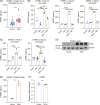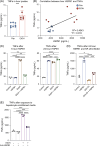Evidence that extracellular HSPB1 contributes to inflammation in alcohol-associated hepatitis
- PMID: 40879491
- PMCID: PMC12401206
- DOI: 10.1097/HC9.0000000000000768
Evidence that extracellular HSPB1 contributes to inflammation in alcohol-associated hepatitis
Abstract
Background: Alcohol-associated hepatitis (AH) is the most life-threatening form of alcohol-associated liver disease (ALD). AH is characterized by severe inflammation attributed to increased levels of ethanol, microbes or microbial components, and damage-associated molecular pattern (DAMP) molecules in the liver. HSPB1 [Heat Shock Protein Family B (Small) Member 1; also known as Hsp25/27] is a DAMP released from stressed cells, including hepatocytes. The goal of this study was to define the role of HSPB1 in AH pathophysiology.
Methods: Serum HSPB1 was measured in a retrospective study of 184 healthy controls (HCs), heavy alcohol consumers (HA), patients with alcohol-associated cirrhosis (AC), and patients with AH recruited from major hospital centers.HSPB1 was also evaluated in liver tissue from HC and AH patients, existing RNA-seq data from ALD patient liver and monocytes, and livers from mice fed a Lieber-DeCarli diet. Cellular models of hepatocyte and macrophage interactions were used to evaluate the role of HSPB1 in inflammation during AH.
Results: Circulating HSPB1 was significantly increased in AH patients, and levels positively correlated with disease-severity scores. HSPB1 was also increased in the livers of patients with severe AH and ethanol-fed mice. In cellular models, ethanol-stressed hepatocytes released HSPB1, which then triggered TNFα-mediated inflammation in macrophages. Anti-HSPB1 antibody prevented TNFα release from macrophages exposed to media conditioned by ethanol-stressed hepatocytes.
Conclusions: Our findings support investigation of HSPB1 as both a biomarker and therapeutic target in ALD. Furthermore, this work demonstrates that anti-HSPB1 antibody is a rational approach to targeting HSPB1 with the potential to block inflammation and protect hepatocytes, without inactivating host defense.
Keywords: TNFα; alcohol-associated liver disease; heat shock protein 27; hepatocyte; macrophage.
Copyright © 2025 The Author(s). Published by Wolters Kluwer Health, Inc. on behalf of the American Association for the Study of Liver Diseases.
Conflict of interest statement
Chelsea Finney is employed by Boehringer Ingelheim. Srinivasan Dasarathy received grants from NIH. Daniel Rotroff consults and owns stock in Clarified Precision Medicine and Genovation Health LLC. Adam Schmitt owns stock and is employed by Arinale Biosciences. He consults for AstraZeneca. The remaining authors have no conflicts to report.
Figures






Update of
-
Evidence that extracellular HSPB1 contributes to inflammation in alcohol-associated hepatitis.medRxiv [Preprint]. 2024 Sep 6:2024.09.06.24313193. doi: 10.1101/2024.09.06.24313193. medRxiv. 2024. Update in: Hepatol Commun. 2025 Aug 29;9(9):e0768. doi: 10.1097/HC9.0000000000000768. PMID: 39281760 Free PMC article. Updated. Preprint.
References
MeSH terms
Substances
Grants and funding
LinkOut - more resources
Full Text Sources
Research Materials
Miscellaneous

